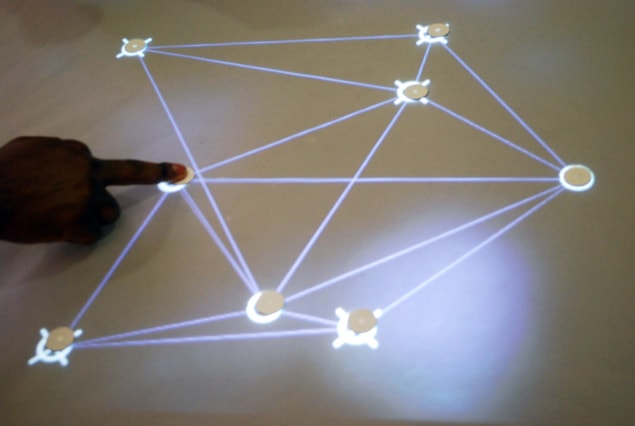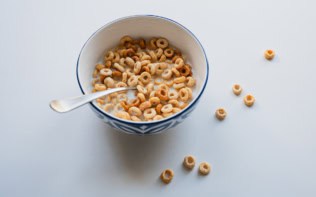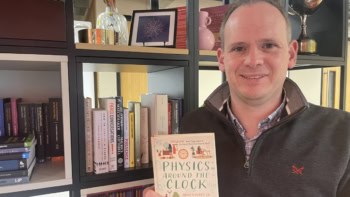
Each year the Royal Society invites the public into its prestigious headquarters in London for its Summer Science Exhibition, where they are wowed by some of the most exciting and innovative research from across the natural sciences. At this year’s event, which ran from 5–10 July, physics featured strongly in a range of exhibits spanning astronomy, optics and condensed matter. Physics World reporter James Dacey went to London armed with a camera and a microphone to capture some of the sights and sounds of the event.
In the week that the final instalment of the Harry Potter films went on general release, it was no surprise that the exhibit on invisibility science was overrun with excited children and their parents. Dressed in a Hogwarts-style cloak, Ulf Leonhardt from the University of St Andrews in Scotland was on hand to talk people through some of the different approaches to achieving invisibility. For a simple demonstration of transparency, Leonhardt dropped glass beads into a fish tank. As the beads have the same refractive index as water, they appear to disappear. Then, to introduce the concept of bending light around an object, the researchers entrapped Winnie-the-Pooh’s friend Eeyore in a pod made from optical fibres. Peering through a viewing hole at one end of the experiment visitors saw the wall behind, as if the donkey were not there.
Just as important as the whizz-bang science, however, were the researchers themselves and their enthusiasm for presenting their work to the public in an engaging and accessible way. One exhibitor who was delighted to be given that opportunity was Matthew Dickinson, an engineering designer from the University of Central Lancashire. Dickenson was part of a team presenting some of the technologies used in energy harvesting – the processes for capturing energy that would otherwise be lost to the atmosphere by heat, light and motion. One particularly noisy prop was the “piezoelectric glockenspiel”, which is designed to show that electricity can be generated directly from materials flexing. The instrument-cum-energy-generator was constructed by attaching ferroelectric strips to the ends of metal bars of varying lengths.
The musical theme continued with a fascinating exhibit hosted by mathematicians from the University of Bristol, who arrived at the event with their “singing graphs”. Their display focused on a giant touchscreen connected to a loudspeaker, which were used to create quantum graphs that could be thought of as a network of guitar strings attached to one another. As the position of nodes in the graph were slid around the surface, the movements were captured by cameras beneath. This caused sounds from the speakers to change in pitch. The exhibit was designed to represent “inverse problems” in physics and mathematics. The idea is that the sounds can be used to reconstruct the shape of graphs, in a similar way to how radar and sonar signals can be used to determine the shape of features in nature.
As well as the colourful sounds, there were also plenty of striking sights, not least at the exhibit explaining structural colour in nature.
A team of researchers from the University of Cambridge were showcasing some of the ways in which animals and plants manipulate light to produce eye-catching colours. Ulrich Steiner, a member of the Cambridge team, was particularly enthusiastic when discussing the way these natural structures grow. He believes that the best way to understand the processes is to recreate the colours in the lab. His group is also interested in how organisms in nature interact through colour, but he admits that in many cases it is still far from clear how these interactions occur.
Another hands-on exhibit offered visitors the chance to produce their very own sheets of graphene – the single-atom-thick layers of carbon dubbed the “wonder material” on account of its outstanding properties. It was for their pioneering work on graphene that Andre Geim and Konstantin Novoselov shared the 2010 Nobel Prize for Physics. This exhibit at the Royal Society was hosted by Geim and Novoselov’s colleagues at the University of Manchester, who were demonstrating the “Scotch tape” method for isolating graphene. This essentially involves ripping a layer off a thin piece of graphite with sticky tape.
No celebration of inspiring science would be complete without reflecting on the achievements of astronomy. But in an interesting exhibit about the Earth’s auroras, part of the display was devoted to a blip in the history of space exploration – when the rocket carrying Cluster satellites crashed in 1996 destroying much of the equipment. The satellites were relaunched in 2000 and they have helped scientists to build a clearer picture of the auroras and the magnetosphere, which helps to shield life on Earth from the Sun’s lethal radiation.
For more photographs from the Royal Society Summer Exhibition, visit the Physics World Flickr page.



